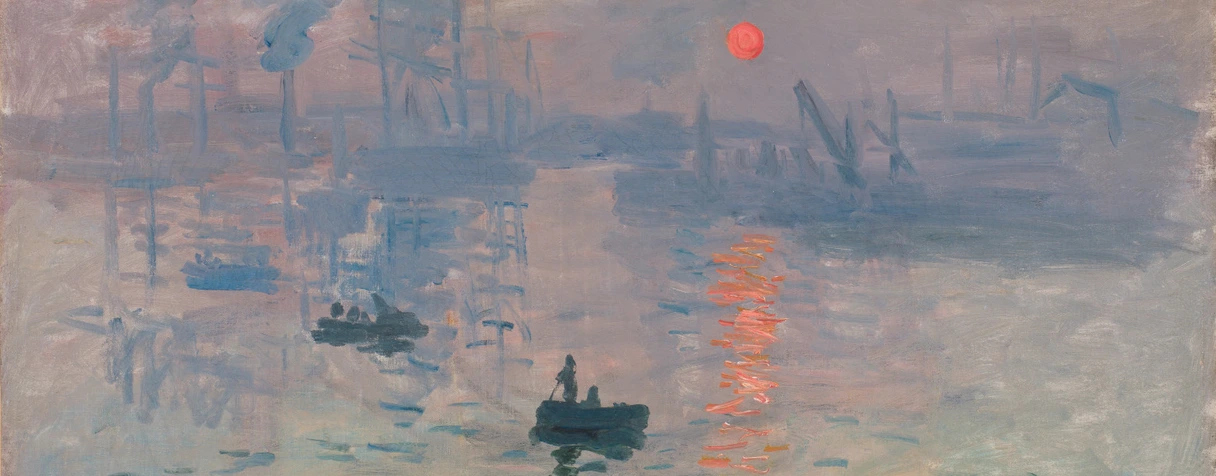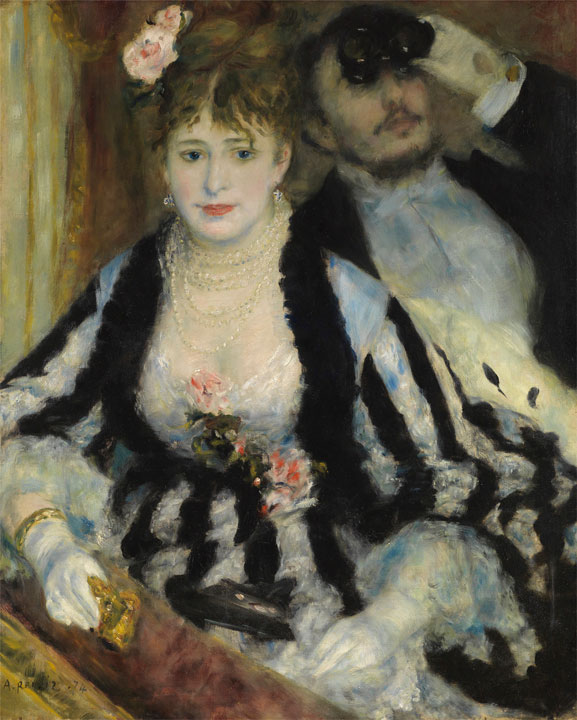March 26th to July 14th, 2024
National Gallery of Art, Washington
September 8, 2024 to January 20, 2025

Impression, Soleil Levant, 1872
Paris, Musée Marmottan Monet
Don Eugène et Victorine Donop de Monchy (donateurs)
© musée Marmottan Monet, Paris / Studio Baraja SLB
What exactly happened in Paris in that spring of 1874, and what sense should we make today of an exhibition that has become legendary? “Paris 1874. The Impressionist Moment” seeks to trace the advent of an artistic movement that emerged in a rapidly changing world.
“Paris 1874” reviews the circumstances that led these 31 artists (only seven of whom are well-known across the world today) to join forces and exhibit their works together. The period in question had a post-war climate, following two conflicts: the Franco-German War of 1870, and then a violent civil war. In this context of crisis, artists began to rethink their art and explore new directions. A little “clan of rebels” painted scenes of modern life, and landscapes sketched in the open air, in pale hues and with the lightest of touches. As one observer noted, “What they seem above all to be aiming at is an impression”.

Auguste Renoir
The Theater Box, 1874
oil on canvas
framed: 106.6 x 91 x 12.3 cm (41 15/16 x 35 13/16 x 4 13/16 in.)
original canvas: 80 x 63.5 cm (31 1/2 x 25 in.)
The Courtauld, London (Samuel Courtauld Trust)
Photo © The Courtauld
On April 15, 1874, an exhibition an exhibition by the “Anonymous Society of Painters, Sculptors, and Engravers, etc.” opened at the Parisian studio of the photographer Nadar on the Boulevard des Capucines. It was a defiant response to the official, government-sponsored annual exhibition known as the Paris Salon. The first exhibition of these Société anonyme artists included works by Claude Monet, Auguste Renoir, Edgar Degas, Berthe Morisot, Camille Pissarro, Alfred Sisley, and Paul Cézanne, later known as impressionists. This now-legendary event is often considered the birth of modernist painting and remains a key moment in the history of Western art.
Honoring the 150th anniversary of the first impressionist exhibition, Paris 1874: The Impressionist Moment brings together some 130 paintings, works on paper, prints, sculptures, and photographs to explore the various ways that artists responded to a city recovering from the violence of war and enormous political and social upheaval.
What exactly happened in Paris in the spring of 1874, and what meaning can we attach to the emergence of this artistic movement? Works shown at the first impressionist exhibition will be put into perspective alongside paintings and sculptures displayed at the official 1874 Salon. This unprecedented juxtaposition will help us understand the visual shock that visitors experienced when first encountering the works of the impressionists.
The exhibition will also explore the circumstances that led more than 30 artists to defy the official system of the Salon, with its judges, prizes, and government approval, by showing their art independently. At the time, France was struggling to recover from its defeat in the Franco-Prussian War of 1870–1871, the siege of Paris and the violence of civil war. Following these crises, artists were rethinking their art, discovering their voices, and exploring new directions.
Eager for autonomy and challenging an academic system that often rejected them, Monet, Degas, Morisot, Pissarro, and their colleagues came together as a société anonyme coopérative, an “anonymous cooperative society.” They exhibited their work in the very heart of Paris, in a photographer’s studio. Scenes of modern life and plein-air landscapes were displayed alongside more conventional paintings, engravings, and sculptures. It represented a common desire to pursue art unconstrained by the established order.
That order will be evoked with a selection of paintings and sculptures from the official Salon, held in the massive Palais de l’Industrie. This annual event, the highlight of the season, featured meticulously crafted mythological, religious, and historical paintings that received government and academic approval. Comparisons between the first impressionist exhibition and the Salon will give us a fresh look at artistic divisions of the day.
Above all, Paris 1874: The Impressionist Moment will invite visitors to consider what constituted an impressionist work. What made it so different and specific? These questions led Louis Leroy, one of the first exhibition’s critics, to coin the term “impressionist”—originally meant sarcastically—that came to describe an artistic movement that would reshape our understanding of modern art. A century and a half after its emergence, it is time to take stock of impressionism and reexamine its radicalism.
Paris 1874: The Impressionist Moment will include works exhibited at Nadar’s studio as well as paintings and sculptures by established artists such as Jean-Léon Gérôme and Antonin Mercié, who were celebrated at the Salon that year. Modern Paris, with its newly built streets and boulevards, entertainment venues, and performances will also be evoked through works by Renoir, Degas, Monet, Eva Gonzalès, and Édouard Manet, shown either at the first impressionist exhibition or submitted to the Salon. Also included will be works by lesser-known impressionist and Salon artists, some of them recently rediscovered and shown for the first time in this context. Finally, the exhibition will feature Monet’s Impression, Sunrise (Impression, soleil levant)—a seminal painting in the history of impressionism.
“This exhibition will closely reconstitute the very first impressionist exhibition,” noted Christophe Leribault, President of Orsay and Orangerie Museums, Paris. “It will invite visitors to immerse themselves in this decisive moment, a major rupture in the history of art, and help us understand its emergence and grasp its radicality.”
“Paris 1874: The Impressionist Moment offers a unique opportunity to explore the origins of one of the most popular and well-known movements in Western art,” said Kaywin Feldman, director of the National Gallery of Art. “We are pleased to partner with the Musée d’Orsay to share this fascinating story with our American audience.”
Exhibition Organization and Support
The exhibition is organized by the National Gallery of Art, Washington, and the Musée d’Orsay, Paris.
Exhibition Tour
Musée d’Orsay, Paris, March 25–July 14, 2024
National Gallery of Art, Washington, September 8, 2024–January 19, 2025
Exhibition Curators
The exhibition is curated in Paris by Sylvie Patry, General Curator of Heritage/Galerie Mennour, Paris, and by Anne Robbins, Curator of Painting, Musée d'Orsay; and at the National Gallery of Art, Washington, by Mary Morton, curator and head of the department of French paintings, and by Kimberly Jones, curator of 19th-century French paintings.
Images

Auguste Lançon
Dead in Line!, 1873
oil on canvas
overall: 160 x 210 cm (63 x 82 11/16 in.)
framed: 197 x 250 x 13.5 cm (77 9/16 x 98 7/16 x 5 5/16 in.)
Musée de la Princerie de Verdun (81.1.401), on loan to the Musée departemental de la Guerre de 1870 & de l'Annexion (DG2009.1.1), Gravelotte
Photo: © Departement de la Moselle, MdG1870&A, Rebourg

Felix Bracquemond
The Divan (after Edouard Manet), 1867
etching
plate: 21.59 x 32.39 cm (8 1/2 x 12 3/4 in.)
sheet: 29.85 x 40.64 cm (11 3/4 x 16 in.)
framed: 40.64 x 50.8 cm (16 x 20 in.)
Samuel Putnam Avery Collection, Print Collection, Miriam and Ira D. Wallach Division of Art, Prints and Photographs, The New York Public Library, Astor, Lenox and Tilden Foundations

- Auguste Renoir
The Dancer, 1874
oil on canvas
142.5 x 94.5 cm (56 1/8 x 37 3/16 in.)
framed: 164.1 x 116.2 cm (64 5/8 x 45 3/4 in.)
National Gallery of Art, Washington, Widener Collection

.jpeg/564px-Zacharie_Astruc_-_Femme_endormie%2C_dans_un_int%C3%A9rieur_artistique_(sc%C3%A8ne_de_somnambulisme).jpeg)








